Kendall Demonstration Elementary School (KDES)
Factor 1 Program Highlight
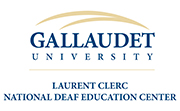 |
Program Description
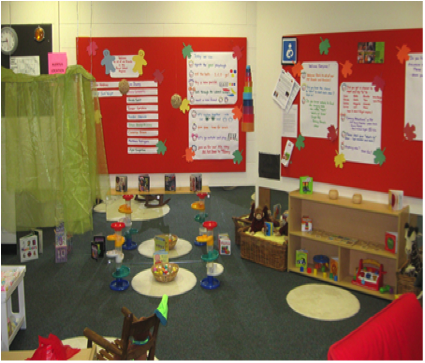
Developed by PIP teachers Debra Cushner, Senoa Goehring, and Brenda Perrodin
Kendall Demonstration Elementary School (KDES) is a tuition-free, federally funded national demonstration program for children who are deaf or hard of hearing located at the Laurent Clerc National Deaf Education Center on the campus of Gallaudet University in Washington, D.C. The Parent-Infant Program (PIP) is a part of the KDES early childhood education program and serves children from birth through age 3 and their families. PIP partners with each family to assess their child's strengths and needs and to explore effective strategies to facilitate all areas of development.
The program includes a range of services provided on site at KDES as well as in the home or in other natural environments. Deaf and hearing professionals work together with families to support the development of linguistic competence through both American Sign Language (ASL) and English. PIP serves children with varying hearing levels as well as children who are deaf or hard of hearing with additional disabilities.
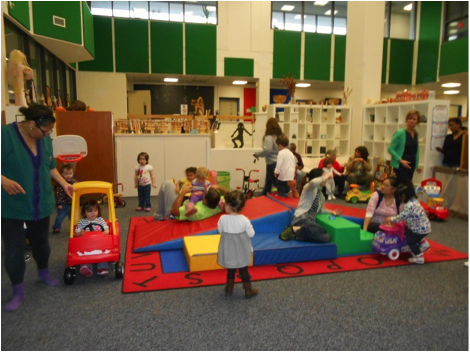 The center-based component of the program includes a play group that infants and toddlers (with their family members and other caregivers) attend at KDES two mornings a week. When the children turn 2, they have the opportunity to enroll in the center-based program for five mornings a week. (Families are encouraged to join as often as possible.)
The center-based component of the program includes a play group that infants and toddlers (with their family members and other caregivers) attend at KDES two mornings a week. When the children turn 2, they have the opportunity to enroll in the center-based program for five mornings a week. (Families are encouraged to join as often as possible.)
The classroom environment is designed to reflect a cheery, cozy, and comfortable home environment with interactive seating areas and several play areas to encourage interaction. To a casual observer, the center-based program may appear to be merely "children at play," but the program includes a finely orchestrated assembly of professionals and families interacting in both informal and formal ways to build family competence in supporting their child's development of both ASL and spoken language in a variety of ways. Families also have the opportunity to meet individually in their home with their teacher and other professionals (as needed) to address identified goals related to language and communication development.
Language and Communication
PIP is designed to partner with families to facilitate and explore their child's development of language in both visual and spoken modalities. The goal is to provide families with the skills to facilitate language and communication using strategies and techniques that are accessible to their child. As it is unknown how a deaf or hard of hearing child will best access language during the early years, the program uses a bilingual approach that is bimodal (i.e., addresses language acquisition in both visual and spoken modalities). This means the program supports the acquisition of both American Sign Language (ASL) and spoken English, each as a separate language. Families are guided in understanding the role of both ASL and spoken English for their child. The program's goal is to facilitate early language in ASL as well as spoken English (to the maximum extent possible based on a child's residual hearing and benefit from listening technologies).
PIP incorporates a systematic and purposeful planning process to identify goals for the development and use of each language and modality. The process includes:
- development of a profile to document the background characteristics of the child (e.g., hearing levels, use of listening technologies, summary of language competencies in visual and auditory modalities based on informal and formal assessment),
- collaboration between professionals and the family to identify a plan to support the development and use of each language/modality for activities and routines throughout the day,
- ongoing assessment and monitoring to evaluate the effectiveness of the plan,
- modification of the plan as needed based on the child's progress or changes in variables (e.g., obtaining a cochlear implant, a decrease in hearing), and
- providing a variety of supports to families so they can facilitate their child's language and communication acquisition based on their individual plan.
Facilitating ASL Development
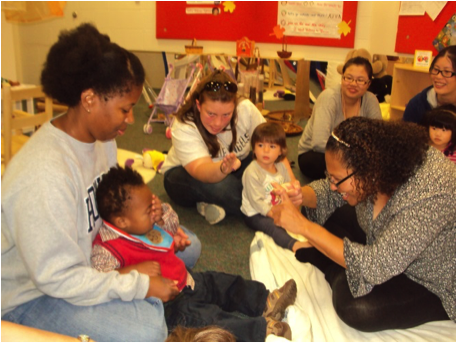 To support the development of ASL, a variety of supports is provided. Services are provided within the center-based program, through family sign language classes, and in the child's home and/or child care setting. For example:
To support the development of ASL, a variety of supports is provided. Services are provided within the center-based program, through family sign language classes, and in the child's home and/or child care setting. For example:
- During the center-based program, a variety of fluent ASL users (deaf and hearing teachers, deaf family members) are integrated into the classroom experience during informal interactions and structured activities. These video links show the PIP in action supporting ASL development:
- Family sign language classes are provided at KDES in the evening and on weekends. Classes are open to KDES families and the community.
- The Shared Reading Project, a home-based service that provides tutors to guide families in learning how to use sign language to read to their deaf or hard of hearing children, is available for KDES families. The program is based on 15 booksharing principles derived from research on how adults who are deaf read books to young children who are deaf.
- Teachers provide home visits. Included are goals to coach families in the development of their ASL skills.
- Facilitating family competence using ASL in the home

- A library of ASL resources (e.g., ASL training websites, ASL stories) are shared with families.
Facilitating Spoken English Development
 Services to support the development of spoken language are incorporated in a variety of ways. The ultimate goal is to facilitate family competence in understanding how they can support their child's acquisition of spoken language (e.g., properly fitted and consistently worn amplification; access to strategies to facilitate auditory, speech, and spoken language development to match the characteristics of their child). Some of the supports provided include:
Services to support the development of spoken language are incorporated in a variety of ways. The ultimate goal is to facilitate family competence in understanding how they can support their child's acquisition of spoken language (e.g., properly fitted and consistently worn amplification; access to strategies to facilitate auditory, speech, and spoken language development to match the characteristics of their child). Some of the supports provided include:
- A staff pediatric audiologist for ongoing evaluation of a child's hearing levels and fitting and monitoring of listening technologies (e.g., hearing aids, FM systems, cochlear implants). The audiologist is an important member of the interdisciplinary team involved in the development of the child's language and communication plan related to spoken language.
- Speech-language pathologists are trained and experienced in working with children who are deaf or hard of hearing to support each child's spoken language goals as identified on their Individualized Family Service Plan. Services are integrated into the center-based classroom routines and activities. Some goals are addressed outside of the classroom, in small groups, or one-on-one. A one-on-one activity can include family coaching on strategies to facilitate spoken language acquisition:
- how to stimulate pre-requisite spoken language skills (i.e., encouraging child to use his or her voice in a meaningful way),

- how to use voice-activated toys,
- how to increase or decrease the challenge of a spoken language interaction by controlling the content or presentation of a communication interaction (e.g., highlighting of key words, changing the number of possible choices available, repetition, familiarity of content)
- how to use techniques to build a bridge between signed and spoken language (e.g., sandwiching or linking, for example "sign it/say it" or "say it/sign it"),
 and
and - media resources to support spoken language development (e.g., using the iPad to facilitate early speechreading skills).

Challenges and Advice
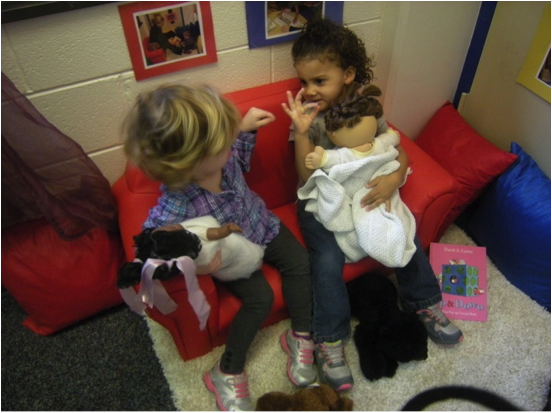 One challenge is debunking inaccurate information that may have been shared with hearing families suggesting that use of sign language may impede their child's development of spoken language. Once families have been in the program, they have the opportunity to observe how the program actively incorporates development of spoken language and how their child is progressing in this area of development. It is helpful to introduce new families who are concerned about this issue to families who have experienced the same concern and then had the experience of watching their child effectively develop spoken language.
One challenge is debunking inaccurate information that may have been shared with hearing families suggesting that use of sign language may impede their child's development of spoken language. Once families have been in the program, they have the opportunity to observe how the program actively incorporates development of spoken language and how their child is progressing in this area of development. It is helpful to introduce new families who are concerned about this issue to families who have experienced the same concern and then had the experience of watching their child effectively develop spoken language.
Another challenge is helping hearing families see that learning ASL is achievable. The goal of the program is to make each family feel comfortable with learning this new language and interacting with the language in natural, meaningful, and fun ways. The most important thing is imparting to families the importance of bonding with their child as they are learning ASL, that learning the language is an evolving process, and not to put off communication if they do not yet know a formal sign.
From KDES program teachers, advice for other programs trying to establish a similar model to support development of both ASL and spoken English is to understand the importance of collaboration with other agencies and professionals. When possible, it is beneficial for the professionals within the school program to take the time to meet with medical professionals and professionals in other educational agencies to share information about what this approach is about and what it has to offer. It is a good idea to share some of the evidence supporting why an approach inclusive of both ASL and spoken English can be advantageous to children who are deaf or hard of hearing. It is also important to clear up any misconceptions related to this type of approach not addressing development of spoken language early in a child's development.
